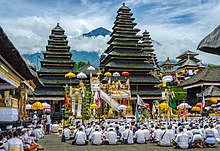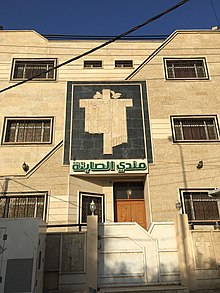 A Baháʼí House of Worship in Wilmette, United States
A Baháʼí House of Worship in Wilmette, United States Pura Besakih is a Hindu temple in Bali, Indonesia
Pura Besakih is a Hindu temple in Bali, Indonesia Wat Kanlayanamit is a Wat or Buddhist temple in Bangkok, Thailand
Wat Kanlayanamit is a Wat or Buddhist temple in Bangkok, Thailand Great Synagogue of Plzeň is a Jewish synagogue in Plzeň, Czech Republic
Great Synagogue of Plzeň is a Jewish synagogue in Plzeň, Czech Republic Saint Basil's Cathedral is a church (place of worship for Christians) in Moscow, Russia
Saint Basil's Cathedral is a church (place of worship for Christians) in Moscow, Russia A place of worship for Islam. The Masjid al-Qiblatayn in Medina, Saudi Arabia
A place of worship for Islam. The Masjid al-Qiblatayn in Medina, Saudi Arabia Golden Temple is the holiest Sikh Gurdwara, located in Punjab, India
Golden Temple is the holiest Sikh Gurdwara, located in Punjab, India Mandaean Beth Manda (Mashkhanna) in Nasiriyah, southern Iraq in 2016. Place of worship for the only surviving Gnostic religion from antiquity
Mandaean Beth Manda (Mashkhanna) in Nasiriyah, southern Iraq in 2016. Place of worship for the only surviving Gnostic religion from antiquity
A place of worship is a specially designed structure or space where individuals or a group of people such as a congregation come to perform acts of devotion, veneration, or religious study. A building constructed or used for this purpose is sometimes called a house of worship. Temples, churches, mosques, and synagogues are examples of structures created for worship. A monastery may serve both to house those belonging to religious orders and as a place of worship for visitors. Natural or topographical features may also serve as places of worship, and are considered holy or sacrosanct in some religions; the rituals associated with the Ganges river are an example in Hinduism.
Under international humanitarian law and the Geneva Conventions, religious buildings are offered special protection, similar to the protection guaranteed hospitals displaying the Red Cross or Red Crescent. These international laws of war bar firing upon or from a religious building.
Religious architecture expresses the religious beliefs, aesthetic choices, and economic and technological capacity of those who create or adapt it, and thus places of worship show great variety depending on time and place.
Buddhism
Main article: Buddhist temple See also: List of Buddhist temples- Candi, Buddhist sanctuaries mostly built during the 1st to 21st centuries in the Indonesian Archipelago
- Chaitya, a Buddhist shrine that includes a stupa
- Jingū-ji, a religious complex in pre-Meiji Japan comprising a Buddhist temple and a local kami Shinto shrine
- Pagoda, a towerlike, multistory structure usually associated with Buddhist temple complexes of East and Southeast Asia.
- Vihara, a Buddhist monastery found abundantly in Bihar
- Wat, the name for a monastery temple in Cambodia and Thailand
Christianity
Main article: Church (building) See also: List of churchesThe word church derives from the Greek ekklesia, meaning the called-out ones. Its original meaning is to refer to the body of believers, or the body of Christ. The word church is used to refer to a Christian place of worship by some Christian denominations, including Anglicans and Catholics. Other Christian denominations, including the Religious Society of Friends, Mennonites, Christadelphians, and some unitarians, object to the use of the word "church" to refer to a building, as they argue that this word should be reserved for the body of believers who worship there. Instead, these groups use words such as "Hall" to identify their places of worship or any building in use by them for the purpose of assembly.
- Basilica (Roman Catholic)
- Cathedral or minster (seat of a diocesan bishop within the Catholic, Orthodox and Anglican churches)
- Chapel ("Capel" in Welsh) – Presbyterian Church of Wales (Calvinistic Methodism), and some other denominations, especially non-conformist denominations. English law once reserved the term "church" to the Church of England. In Catholicism and Anglicanism, some smaller and "private" places of worship are called chapels.
- Church – Iglesia ni Cristo, Orthodox, Catholic, Protestant denominations
- Kirk (Scottish–cognate with church)
- Meeting House – Religious Society of Friends
- Meeting House – Christadelphians
- Meeting House and Temple – Mormons
Latter-day Saints use meeting house and temple to denote two different types of buildings. Normal worship services are held in ward meeting houses (or chapels) while Mormon temples are reserved for special ordinances. - Temple – French Protestants
Protestant denominations installed in France in the early modern era use the word temple (as opposed to church, supposed to be Roman Catholic); some more recently built temples are called church. - Orthodox temple – Orthodox Christianity (both Eastern and Oriental)
an Orthodox temple is a place of worship with base shaped like Greek cross. - Kingdom Hall – Jehovah's Witnesses may apply the term in a general way to any meeting place used for their formal meetings for worship, but apply the term formally to those places established by and for local congregations of up to 200 adherents. Their multi-congregation events are typically held at a meeting place termed Assembly Hall of Jehovah's Witnesses (or Christian Convention Center of Jehovah's Witnesses).
Classical antiquity
Ancient Greece
- Greek temple (ναός) , for the religions in ancient Greece
Ancient Rome
- Roman temple, for the religions of ancient Rome
- Mithraeum, for the Mithraic mysteries
Hinduism
- Hindu temple (Mandir), Hinduism
A Hindu temple is a symbolic house, seat and body of god. It is a structure designed to bring human beings and gods together, using symbolism to express the ideas and beliefs of Hinduism. The symbolism and structure of a Hindu temple are rooted in Vedic traditions, deploying circles and squares. A temple incorporates all elements of Hindu cosmos—presenting the good, the evil and the human, as well as the elements of Hindu sense of cyclic time and the essence of life—symbolically presenting dharma, kama, artha, moksa, and karma.
Islam
A mosque (Arabic: مسجد, romanized: masjid), literally meaning "place of prostration", is a place of worship for followers of Islam. There are strict and detailed requirements in Sunni jurisprudence (fiqh) for a place of worship to be considered a masjid, with places that do not meet these requirements regarded as musallas. There are stringent restrictions on the uses of the area formally demarcated as the mosque (which is often a small portion of the larger complex), and, in the Islamic Sharia law, after an area is formally designated as a mosque, it remains so until the Last Day.
Many mosques have elaborate domes, minarets, and prayer halls, in varying styles of architecture. Mosques originated on the Arabian Peninsula, but are now found in all inhabited continents. The mosque serves as a place where Muslims can come together for salat (صلاة ṣalāt, meaning "prayer") as well as a center for information, education, social welfare, and dispute settlement. The imam leads the congregation in prayer.
Jainism
Derasar is a word used for a Jain temple in Gujarat and southern Rajasthan. Basadi is a Jain shrine or temple in Karnataka There are some guidelines to follow when one is visiting a Jain temple:
- Before entering the temple, one should bathe and wear freshly-washed clothes
- One should not be chewing any edibles
- One should try to keep as silent as possible inside the temple.
- Mobile phones should not be used in the temple.
Judaism
- Synagogue – Judaism
- Some synagogues, especially Reform synagogues, are called temples, but Orthodox and Conservative Judaism considers this inappropriate as it does not consider synagogues a replacement for the Temple in Jerusalem.
Some Jewish congregations use the Yiddish term 'shul' (from the same ancient Greek source as the English word "school") to describe their place of worship, or the Hebrew Beyt ha-Knesset (Hebrew בית הכנסת) meaning house of assembly.
Mandaeism
- Mandi / Mashkhanna / Beth Manda – Mandaeism
- A mandi or Beth Manda (Beit Manda or Bit Manda, 'house of knowledge') is a cultic hut and place of worship for followers of Mandaeism.
Norse paganism
Shinto
Sikhism
Taoism
Zoroastrianism
- Fire temple - All Zoroastrian temples fall into the Fire temple category.
Vietnamese ancestral worship
- Nhà thờ họ. Historically speaking Vietnamese people tumi tum
See also
- Altar
- Arming places of worship
- Bahá'í House of Worship
- Ibadat Khana
- Sacred space
- Shrine
- Religious architecture
- Reliquary
- List of largest church buildings in the world
- List of largest mosques in the world
- Temple
References
- "The New Testament Definition of the Church". Retrieved 23 June 2009.
- Gee, Matthew (8 May 2009). "Meeting for Church Affairs". The Friend. 167 (19). London, UK: 8. ISSN 0016-1268.
- ^ Robinson, James. Religions of the World: Hinduism.1st. Chelsea House Publishers, 2004. Page 72. ^ Werner, Karel (1994). A Popular Dictionary of Hinduism. Curzon Press. ISBN 0-7007-1049-3. ^ a b c Narayanan, Vasudha. "The Hindu Tradition". In A Concise Introduction to World Religions, ed. Willard G. Oxtoby and Alan F. Segal. New York: Oxford University Press, 2007 ^ Bain, Keith, Pippa Bryun, and David Allardice. Frommer's India. 1st. New Jersey: Wiley Publishing, 2010. Page 75 ^ Harley, Gail M (2003). Hindu and Sikh Faiths in America. Facts on File, Inc. ISBN 0-8160-4987-4. ^ http://www.mandir.org/awards&opinions/Buildings%20and%20structures.htm Archived 10 February 2009 at the Wayback Machine
- Stella Kramrisch (1946). The Hindu Temple. Motilal Banarsidass. pp. 135, context: 40–43, 110–114, 129–139 with footnotes. ISBN 978-81-208-0223-0., Quote: "The temple is the seat and dwelling of God, according to the majority of the names" (p. 135); "The temple as Vimana, proportionately measured throughout, is the house and body of God" (p. 133).
- George Michell (1977). The Hindu Temple: An Introduction to Its Meaning and Forms. University of Chicago Press. pp. 61–62. ISBN 978-0-226-53230-1.; Quote: "The Hindu temple is designed to bring about contact between man and the gods" (...) "The architecture of the Hindu temple symbolically represents this quest by setting out to dissolve the boundaries between man and the divine".
- Stella Kramrisch (1946). The Hindu Temple. Motilal Banarsidass. pp. 19–43, 135–137, context: 129–144 with footnotes. ISBN 978-81-208-0223-0.
- Stella Kramrisch, The Hindu Temple, Vol 2, Motilal Banarsidass, ISBN 978-81-208-0222-3, pp. 346–357 and 423-424
- Klaus Klostermaier, The Divine Presence in Space and Time – Murti, Tirtha, Kala; in A Survey of Hinduism, ISBN 978-0-7914-7082-4, State University of New York Press, pp. 268–277.
- George Michell (1977). The Hindu Temple: An Introduction to Its Meaning and Forms. University of Chicago Press. pp. 61–76. ISBN 978-0-226-53230-1.
- "Basadi".
- CultureShock! India: A Survival Guide to Customs and Etiquette, Gitanjali Kolanad, Marshall Cavendish International Asia Pte Ltd, 2008 p. 45
- Leo Rosten, The Joys of Yiddish, © 1968; Pocket Books edition, 1970, p. 379
Further reading
 Media related to Places of worship at Wikimedia Commons
Media related to Places of worship at Wikimedia Commons- James P. Wind, Places of worship: exploring their history, Rowman Altamira, 1997
- Vaughan Hart, Places of worship, Phaidon, 1999
- Eric Kang, The Place of Worship, Essence Publishing, 2003
| Places of worship | |
|---|---|
| Baháʼí Faith | Baháʼí House of Worship |
| Buddhism | |
| Christianity | Church |
| Hinduism | |
| Jainism | Jain temple or Derasar or Basadi |
| Judaism | Synagogue or Shul |
| Islam | |
| Mandaeism | Mandi or Mashkhanna or Beth Manda |
| Paganism & modern paganism | |
| Shintoism | Shinto Shrine or Jinja |
| Sikhism | Gurdwara |
| Taoism | Taoist temple or Dàoguàn |
| Zoroastrianism | Fire temple or Agiary or Atashkadeh or Atashgah or Dar-e Mehr |
| Varying religions and beliefs | |
| Note: Sorted alphabetically except the last one | |